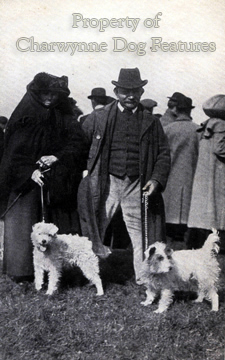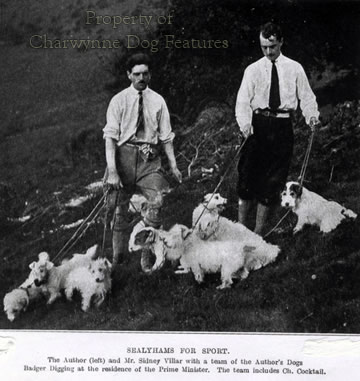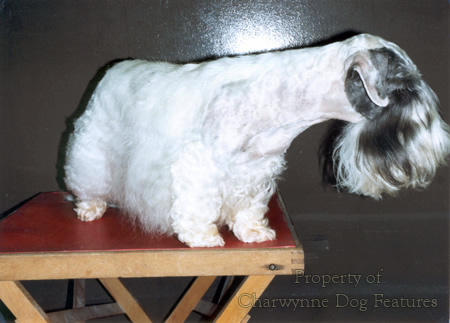742 SAVING THE SEALYHAM
SAVING THE SPORTING SEALYHAM
by David Hancock
 “Gradually this form of sport (badger-digging, DH) was discontinued…I wonder what sort of account our present-day Sealyhams would give of themselves if they were given the chance – everyone is concerned with their beauty for shows or their winning ways as pets nowadays – and sometimes I have wondered whether everyone has forgotten the breed’s raison d’etre, and whether that is partly responsible for the fall from the great popularity of those early days.”
“Gradually this form of sport (badger-digging, DH) was discontinued…I wonder what sort of account our present-day Sealyhams would give of themselves if they were given the chance – everyone is concerned with their beauty for shows or their winning ways as pets nowadays – and sometimes I have wondered whether everyone has forgotten the breed’s raison d’etre, and whether that is partly responsible for the fall from the great popularity of those early days.”
Frida Chenuz writing in her Sealyhams, Ernest Benn Ltd., 1956.
Created by a demanding Victorian sportsman in what was then a remote part of Britain, the Sealyham Terrier gained an early reputation as an earth-dog and then between the two World Wars as a companion dog. The breed’s creator, John Tucker-Edwardes developed his breed in the golden age for terriers: the Rev John Russell with his hunt terriers, James Hinks with his Bull Terriers and Colonel Edward Malcolm with his West Highland Whites. Tucker-Edwardes wanted a dog that could accompany him when he hunted his Otterhounds. He is reputed to have tested his young terriers on a captive polecat before retaining them; this may have rehearsed them for the otter but wouldn’t have benefited their ferret-friendliness! He is alleged to have used corgi-blood in his breeding plans, which is unlikely. Why use a brown herding dog when hard-bitten working terriers abounded in that part of Wales at that time, some of them with the white jacket he favoured. His early specimens too were neither short-legged nor long-muzzled. For such a serious sportsman, performance mattered way ahead of appearance. In 1912, the Sealyham Terrier and Badger Digging Association was formed with the object of conserving the working instincts of the breed and to prevent it from becoming a purely ornamental show dog; it could not compete however with the power of the exhibitors. 
The show ring in time claimed both Welsh terrier breeds, with the Welsh Terrier by name holding its place and the Sealyham under threat of extinction in the coming decades. Luckily there are devotees still working their own brand of Sealyham, keeping the pioneer breeders' work alive. The demise of the admirable Sealyham Terrier has been sad to witness over the years. With Kennel Club registrations going from 601 in 1914 to 2617 in 1925, and from 936 in 1960 to a mere 43 in 2008, this breed has had its share of fickle fanciers. Eighty years ago, Pierce O'Conor, in his Sporting Terriers, was writing: 'It is to be regretted, however, that in the past judges have too often awarded the highest honours at shows to large, heavy, clumsy-looking animals to the great detriment of the breed...The real working type should not be extravagantly short of leg, and is comparatively light in bone with rather a long body.'
One of the best-known Sealyham breeders of the last century, Miss Frida Chenuz, has been quoted as saying that a Sealyham could really not be too low to the ground and that when judging one should look for type first and soundness second; for me that is a sure recipe for disaster in any breed, especially a sporting one. The Kennel Club’s standard for the breed demands an ideal weight for male Sealyhams of 20 lbs; for the Fox Terrier, 3 inches taller, it is only 18lbs. Yet in the early Sealyham shows there were classes for exhibits under 16 lbs. Some of Sir Jocelyn Lucas’s foundation stock weighed between 12 and 15 lbs but were top quality terriers when carrying out their declared function. The sadness of rating dogs entirely on their appearance can lead to a totally useless earth-dog bristling with ‘breed-type’ being valued more than a wholly efficient working terrier, in the same breed, that lacks breed points. Sporting terriers must always be rated for what they can do. 
The acknowledged expert on the Sealyham in his day, Fred W Lewis, writing in Hounds and Dogs, The Lonsdale Library, Seeley, Service & Co., 1932, warned of the dangers of exaggerating the breed: “The Show Sealyham is undoubtedly a very handsome, attractive animal, and when one compares the prize-winning specimens of today with those which were first benched at the Crystal Palace Show in 1910 the improvement which has been effected is truly astonishing. Many authorities argue that the craze for a powerful, and what is termed a punishing jaw has been carried to excess, and, although this is to some extent true, there is now a decided tendency amongst most judges to favour a type free from very pronounced exaggerated features. Hence breeders are striving to produce a well-balanced terrier if possible of a WEIGHT rather under than over 20lb. for dogs, and 18lb. for bitches.”
In his book The Sporting Terrier of 1992, Brian Plummer wrote: 'Sadly, one of the breeds that has been most damaged by the whims of breeders seeking to produce animals solely for exhibition has been the Sealyham terrier.' The portrayals of this breed down the years indicate all too vividly the descent from spunky active lively earth-dog to chunky less active specimen quite unable to fulfill its foundling function. If the registrations are anything to go by, all the show breeders have achieved is the obliteration of their favourite breed. And the Kennel Club, the self-appointed guardian of breeds of dog, has watched this happen. Once function is not bred for then the writing is on the wall for sporting and working breeds.
The famous terrier-breeder Sir Jocelyn Lucas hunted a pack of Sealyhams from his famous Ilmer kennel but it was his disillusionment with the show Sealyham which inspired his experiment with an outcross to the Norfolk terrier, then little known outside its native county. His working lines had been based on a dozen 'mini-Sealyhams' from the Master of the Pembrokeshire Foxhounds, subsequently blended with the renowned Gladdish Hulke's stoat-hunting working terrier pack, which Sir Jocelyn bought. Seeking a smaller working Sealyham, he outcrossed in the early 1950s to a red Norfolk terrier (which he referred to as a Norwich or Trumpington terrier), and was so pleased with the litter that he attempted to stabilise the type. He later described this type as 'death on rats and rabbits'.
Finding the show Sealyham too big, too cloddy, over-furnished, with disappointing temperament and whelping difficulties, Lucas sought a smaller-headed, harsh-coated, coloured terrier which possessed both the physique and the character for hunting. He did not care for the excessive coat and box heads of the increasingly popular post second World War show Sealyham. His 'new breed' had handsome red jackets and a perky assertiveness which he admired. His first cross Sealyham-Norfolks were mainly coloured, ranging from red-tan to wheaten and even black and tan. But the second cross produced a proportion of mainly white or white-bodied progeny. We have both the Lucas Terrier and the Sporting Lucas Terrier breeds with us to this day. 
Writing on the evolution of the Sealyham in his book on the breed, published by Simpkin Marshall, Ltd., of 1929, Lucas recorded: “Just before the war, one breeder at least introduced a West Highland cross to reduce the size…Show wire fox-terrier bitches were also tried in later days in order to improve coats and fronts…Fifteen or twenty years ago few litters of Sealyhams were level or true to type. Nearly every litter consisted of one or two short-legged dogs, one or two medium ones, and one at least that tried to look like an Airedale as regards shape…There was a boom in the breed. Everyone in Pembrokeshire who had a bitch put it to a local dog, and the litter went to England…One breeder at least, a few years ago, tried a cross with the Clumber Spaniel to get heads.” Against that background, is it at all surprising that even today we get heavy-boned, long-bodied, boot-box headed Sealyhams exemplifying the modern breed, to the despair of those who favour sporting terriers?
Lucas and his pack were often invited to the big estates of Hertfordshire to act as beaters on rabbit and cock pheasant shoots, using from ten to fifteen couple but hunted using the hunting horn and whip. These terriers were described as small, muscular, hardy, sharp as tacks with hard coats and punishing jaws. Much more recently, three enthusiasts: Morris Richardson, Jimmy Thompson and Colin Rivers, bred Sealyhams solely for work over three decades, making occasional use of Russell blood. Noel Culleton in Ireland has also worked their stock. Even more recently, Harry Parsons has striven to promote a working type, sensibly displaying them at the CLA Game Fair, which can only do good..jpg)
The better show ring type has been produced by breeders like Margery Good, who never over-bred but imported valuable stock from Sweden and cooperated with another talented breeder, France Bergeron in Canada. Margery developed an exceptional line of bitches, mainly from the Goodspice bitch line. As with nearly every pedigree breed, the Sealyham has its share of inheritable defects, mainly eye problems such as retinal dysplasia and glaucoma, the latter often resulting from lens luxation. Exaggeration of coat length encourages skin problems and morphologically it is never wise to inflict heavy bone, short legs and an overlong head on a dog. This game little breed deserves the best working terrier anatomy as well as the very best patronage. Breed type should never have a higher priority than functional soundness – as Lucas once demonstrated for all to see!
“The Sealyham terriers nowadays so much advertised, are too short-legged and broad-chested to properly negotiate rock crevices or surmount ledges underground…in many situations their build prevents them doing their best work. If we were asked to give a specification of such a terrier it would be as follows: Weight 15lb to 16lb; coat, thick and wet-resisting; chest narrow, but not so much so as to impede the free action of heart and lungs, legs sufficiently long to enable the dog to travel above ground…jaw powerful but not too long…”
from Foxes, Foxhounds and Fox-Hunting by Richard Clapham, Heath Cranton Ltd, 1936.